原创Role of Media Coverage in Keeping Lid on Government Expenses
Posted 中国经济学人
tags:
篇首语:本文由小常识网(cha138.com)小编为大家整理,主要介绍了原创Role of Media Coverage in Keeping Lid on Government Expenses相关的知识,希望对你有一定的参考价值。

Zhang Qi (张琦)1, Bu Danlu (步丹璐)2 and Yu Zhi (郁智)3
1 Research Institute of Government Accounting, Zhongnan University ofEconomics and Law, Wuhan, China
2 School of Accounting, Southwestern University of Finance and Economics,Chengdu, China
3 Business School, University of International Business and Economic,Beijing, China
Abstract: Information monopoly of bureaucrats helps themmaximize discretionary budget. Public disclosure of budget can alleviateinformation asymmetry between government and the public and empower publicsupervision on government budget. With information intermediary function andreputational governance function, the media exert a budget intervention effectin the public disclosure of government budget, which further increases theeffect of government budget disclosure. This paper investigates how mediareports influence “three public expenses” (TPE) budget planning of centralgovernment departments by examining media reports on the disclosure of budgetand final accounts and using TPE budget as a proxy variable for discretionarybudget of bureaucrats. We have reached thefollowing findings: (1) The higher the TPE budget implementation rate, thegreater budget growth will be. But this correlation can be restrained by mediaattention; (2) Different stance of the media may exert different governanceeffects on TPE budget. Positive coverage may motivate bureaucrats to restrainthe positive impact of TPE budget implementation on budget growth. However, negativemedia coverage will exert its budget interventioneffect only when administrative governance mechanism intervenes. This study hasbroadened research on the media’s governance effect from the perspective of governmentbudget transparency and verified that under China’s unique institutionalbackground, the media may still play a positive role in public sectorgovernance.
Key words: media attention, stance of media report,public opinion environment, “three public expenses” budget
JEL Classification Codes: H83, P16, D73
1. Introduction
Public supervision is a prerequisite forgood governance (Yu Keping, 2000). As rational economic men, bureaucrats have astrong motive to pursue budget maximization (Niskanen, 1971) to optimize theirpersonal utility function. With “bilateral monopoly of information” in theproduction and consumption of public goods, bureaucrats are able to maximizediscretionary budget (Gonzalez and Mehay, 1985). In order to diminishgovernment monopoly of information, not only should the government be obligatedto disclose its financial information but public supervision mechanism shouldbe introduced as well. However, in the face of financial information disclosedby government, the general public may demonstrate “rational ignorance” due toexorbitant cost of analysis and meagre personal return. The public needs torely on certain intermediaries of information to make analysis and evaluation,thus transferring the cost of information collection (Downs, 1957) and getting assistedin performing their duty of public supervision.
As discovered in literature, the media asthe “fourth power” can exercise the above-mentioned role of informationintermediary and ease information asymmetry between government and its stakeholders(Healy and Palepu, 2001; Bushee et al., 2010; Kong Dongmin et al., 2013, etal.) and influence public policy choice and voting decisions (Sanders et al.,1993; Nadeau et al., 1999; Erikson et al., 2002; Soroka, 2006, et al.) throughreputational mechanism (Miller, 2006; Core et al., 2008; Joe et al., 2009;Zheng Zhigang et al., 2011, et al.) or by triggering administrativeintervention (Dyck et al., 2008; Li Peigong and Shen Yifeng, 2010, et al.),giving rise to governance effect. Based on above studies, Zhang Qi and LyuMinkang (2015) further discovered that media enquiry reports significantlyincreased the probability, speed and quality of government response, whichexplains that the media can indeed play a governance role in budget transparency.However, whether the media can effectively intervene in government budgetplanning is not supported by empirical evidence.
Hence, this paperinvestigates how media reports influence the budget planning of “three publicexpenses” (governmental expenses on official receptions, vehicles and overseastrips) (hereinafter abbreviated as “TPE”) of central government departments byexamining media reports on the disclosure of budget and final accounts during2011-2014 and using TPE budget as a proxy variable for discretionary budget of bureaucrats.This paper may have the following contributions:
(1) Explains how mediareports influence the behaviors of bureaucrats in budget planning, i.e. the media’sgovernance effect in public sector;
(2) Clarifies that media intervention is targetedat incremental motive in government budget planning, i.e. current-phase TPEbudget implementation will drive, rather than restrain, next-phase budgetgrowth.
(3) Provides a detailed analysis on how positiveand negative media reports affect governance. Positive reports serve as an incentivefor bureaucrats to pursue long-term reputational benefits and give upshort-term opportunist and selfish behavior, thus restraining TPE budgetgrowth. Negative reports, however, may only indirectly increase the chance and severityof penalties on bureaucrats through “problem identification” function duringthe intervention of administrative governance mechanisms such as annual auditsand promulgation of the Eight-Point Ruleson Improving Work Style and Connecting with the Masses (hereinafter “Eight-PointRules”, a major campaign to curb extravagant government spending).
(4) Clarifies the relationship betweenaccountability through media coverage (negative reports) and administrative accountability.In government budget transparency, administrative governance mechanism remainsthe foundation for media to exert governance effect, being a means by whichnegative reports does budgetary intervention, instead of being triggered bynegative reports.
2. Theoretical Analysis and Hypotheses
2.1 Media Attention and Restraint of TPEBudget
InChina, TPE budget in the total expense budget is the balance of total budgetaryincome minus project expenses and transfer payments as well as all the related necessaryexpenses. As a relatively controllable discretionary budget for maintaininggovernment operation, TPE budget can be a proper object of observation on themotives of government and its bureaucrats for budget maximization. TPE budgetincludes spending on overseas tours of bureaucrats, purchase and use ofvehicles and public receptions, which constitute a major share in governmentadministrative cost. Given the monotonic positive correlation between the sizeof TPE budget and the grade of vehicles, comfort of overseas tours and thelevel of government receptions including catering and entertainment, there is apotential motive for bureaucrats to maximize TPEs.
Inaddition, government budget planning is largely influenced by traditionalincremental budget system (Leone and Rock, 2002), i.e. how TPE budget is implementedin current phase determines how much budget can be granted in the next phase.Incremental budget approach may disincentivize government from reducingbudgetary expenses and may even encourage it to exhaust current-phase budget inorder to maintain the same or higher level of next-phase budget. In budgetplanning for the next phase, with the same or higher level of budget, thegovernment will not have to consider the actual needs of operation or the typesof executive functions. Under information asymmetry between the public andgovernment regarding the basis of budget planning, the higher budgetimplementation rate, the greater extent the budget growth will be.Current-phase implementation of TPE budget becomes a major driver for thegrowth of next-phase budget. Strong motives to maximize discretionary budgetand expand resource dominance (Chow et al., 1988) may induce bureaucrats topursue the growth of TPE budget under the above-mentioned mechanism wherehigher budget implementation rate leads to higher budget growth. Such growth ofTPE budget derives from the incremental motive of bureaucrats for budgetplanning, rather than the real demand of their respective departments and is anelastic part of TPE budget that can easily be influenced by external governancemechanisms such as media supervision.
Afterthe disclosure of current-year central government budget in March andprevious-year final accounts in July of each year, the media will pay closeattention to the released budget and final account information. In performingtheir role as information intermediaries, the media will ease government-publicinformation asymmetry, bring budget planning and implementation under public scrutiny,and help restrain bureaucrats from increasing TPE budget in the next year. Sucha role of the media is realized through: (1) publishing and/or quoting officialbudget and final account statistics; (2) conducting cross-departmental andcross-year analysis of budget and final account information; and (3) acquiringadditional information by interviewing bureaucrats and scholars. Hence, webelieve that by serving as information intermediaries, the media caneffectively restrain the incentive effect of current-phase implementation rateof TPE budget on next-phase budget growth. Thus, we put forward Hypothesis 1.
Hypothesis1: Media attention inhibits the incentive effect of current-phase budget implementationof TPE on next-phase budget growth.
2.2 Stance of Media Coverage andRestraint of TPE Budget
Inthe Western world, studies on media’s governance effect in public sectors arebased on the foundation of election and voting systems, through which the pressmay influence the motives and behaviors of bureaucrats. In China’s uniqueinstitutional context characterized by integrated and hierarchical politicalpower, government agencies are mainly subject to the vertical supervision fromsuperior authorities, while horizontal supervision and restraint are verylimited (Zhou Li’an, 2007). Higher levels of CPC committees or government exerteffective control over lower levels of government by influencing the careers ofsubordinate bureaucrats. Inherent incentives and constraints within thepolitical system have become key factors that determine the motives andbehaviors of bureaucrats, diminishing the media’s governance effect.
Afterthe release of current-year budget and previous-year final accounts, the mediamay provide positive coverage, which is favorable to the reputation ofgovernment and its bureaucrats. In this sense, positive coverage can beregarded as an auxiliary, observable and quantifiable performance indicatoraside from GDP growth and sends a positive signal of good performance tosuperior CPC committees or government authorities. Quantity and stance ofpositive media coverage reflect the media’s attitude towards government and itsbureaucrats and thus can increase the chance and extent for them to receiveadministrative incentives. Despite having no final say in providing thoseincentives, the media may affect the discretion of high-level authorities onthe performance of bureaucrats through reputational mechanism (Piotroski etal., 2015). Under reputational mechanism, bureaucrats will partially give up short-termopportunist and selfish behaviors in exchange for long-term reputationalbenefits (Kreps et a., 1982) and a greater chance and extent of receivingadministrative incentives. In regard to the budget planning of TPE, a possiblestrategy of government and its bureaucrats desirous to receive positive mediacoverage is to partially give up the pursuit to maximize TPE budget (giving upshort-term opportunist and selfish behaviors) to diminish the impact ofincremental motives and the growth of TPE budget in response to the positivecoverage by the media in current year with the expectation to continuereceiving such media support (thus gaining long-term reputational benefits).Hence, in the process of government budget disclosure, positive media coveragewill incentivize officials to partially give up their incremental motives for TPEbudget planning. Hence, we put forward Hypothesis 2.
Hypothesis2: Positive coverage may inhibit the incentive effect of current-phase budgetimplementation of TPE on next-phase budget growth.
Onthe other hand, the media may also publish negative coverage after thegovernment releases current-year budget and previous-year final accounts.Negative coverage may cause reputational damages to bureaucrats. However,whether negative coverage will cause bureaucrats to receive administrativepenalties through reputational mechanism depends on two critical factors:first, the decision of involved government to respond and second, theintervention of administrative governance mechanism.
Incase administrative governance mechanism does not intervene, the governmentinvolved may make two opposing decisions in response to negative coverage withdifferent expected results: first, it may lower the growth of TPE budget inresponse to negative media coverage. While quenching negative media coverage inthe short term, this decision actually recognizes the overspending of TPE in previousyear or the overestimate of TPE budget for current year, thus increasing thechance and extent for relevant departments to be held accountable[1]. Thesecond option for the involved government is to stick to TPE budget for thenext year without responding to negative media coverage. Despite inconsistencyof such a decision with media expectation, it sends a signal to higher levelsof government that the actual TPE of the involved government in previous yearand its current-year budget planning are reasonable and normal. Because it is thehigher levels of government, rather than the media, that have the right totrigger administrative penalty mechanism, the decision not to lower budget makesit less likely for the involved government to be held accountable. It can beexpected that without administrative intervention, the government will stick toits original plan and draft its TPE budget for the next year according to theimplementation rate of TPE budget in current year.
However,in the event of an administrative intervention, the governance effect ofnegative media coverage can be brought into play through “problem identification”function (Soroka, 2006), including:
(1)Government audit: in case government audit intervenes, media coverage will provideproblem clues for audit supervision, thus aggravating consequences on theinvolved government and damaging its interests (Zhang Qi et al., 2013). Underdual pressures of media and audit supervision, a rational decision of theinvolved government is to lower TPE budget for the next year in order to dispelnegative public opinion and reduce the chance and extent of administrative penaltiesthat may arise from audit supervision.
(2)Enactment of the Eight-Point Rules. In December 2012, the Politburo of the CPCCentral Committee deliberated and adopted the Eight-Point Rules, which provideausterity requirements on government meetings, overseas tours, receptions andbanquets. Obviously, these requirements are targeted at addressing exorbitantTPEs. In the height of this campaign, any negative media report on TPE may trigger“problem identification mechanism” against bureaucrats for their violation ofthe Eight-Point Rules. Once a violation is exposed, higher levels of CPC committeesor government will not hesitate to impose penalties on the involved governmentand its bureaucrats. Because of tremendous attention to the Eight-Point Rules,violations will cause great disrepute on the part of government. Under the dualeffects of reputational mechanism and administrative accountability, theinvolved government will be forced to lower the growth of TPE budget for thenext year. In a nutshell, we believe that administrative intervention is thepremise for negative media coverage to restrain TPE budget. Hence, we putforward Hypothesis 3.
Hypothesis3: Under the intervention of administrative governance mechanism, the “problemidentification function” of media’s negative coverage inhibits the incentiveeffect of the implementation rate of current-phase TPE budget on next-phasebudget growth.
3. Research Design
3.1 Selection of Samples and DataSources
Since2011, China’s central government began to disclose the budgetary and finalaccount information of TPE, which drew extensive public and media attention. Byexamining media reports on the disclosure of budget and final accounts during2011-2014, this paper investigates the governance role of the media ingovernment budget planning process. According to the names of centralgovernment departments published on official website, we have searched all thenews reports on budget and final account information of various departmentsduring 2011-2014 using Baidu news search. Because most news reports werepublished within one month after budget and final account disclosure, we haveidentified the period of one month after such disclosure as the window periodfor data collection. In order to retrieve and separate news reports, we searchedfive combinations of keywords including “department + budget / final account”, “department+ three public expenses”, “department + public vehicles”, as well as “department+ overseas tours” and “department + receptions.” All the news reports thusobtained are manually identified to delete repetitive ones.
3.2 Model Design and VariableExplanation
3.2.1 Model Design
In order to verify thegovernance effect of media coverage on TPE budget planning, we have created thefollowing model:
[1]TPE-related regulations such as Provisionson Frugality and Anti-Waste of CPC and Government Agencies and Opinions of State Council General Office onFurther Inspections on the Implementation of Austerity Rules (GuoBanFa[2013] No.105) jointly released by CPC Central Committee and the State Councilall stipulate that government (department) chiefs are the primary responsiblepersons for TPE funds and may be held accountable for their use.
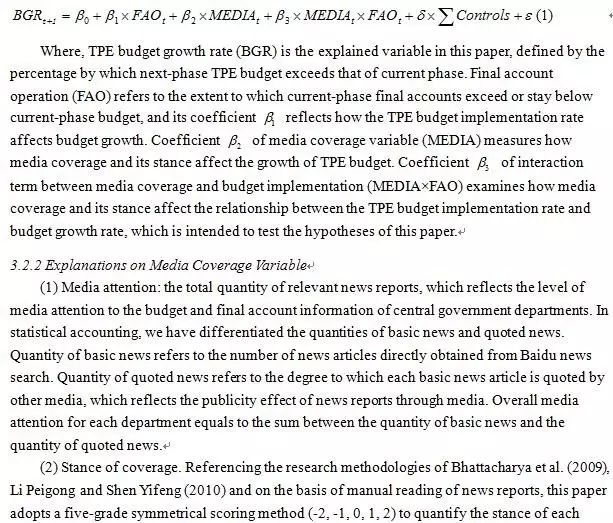
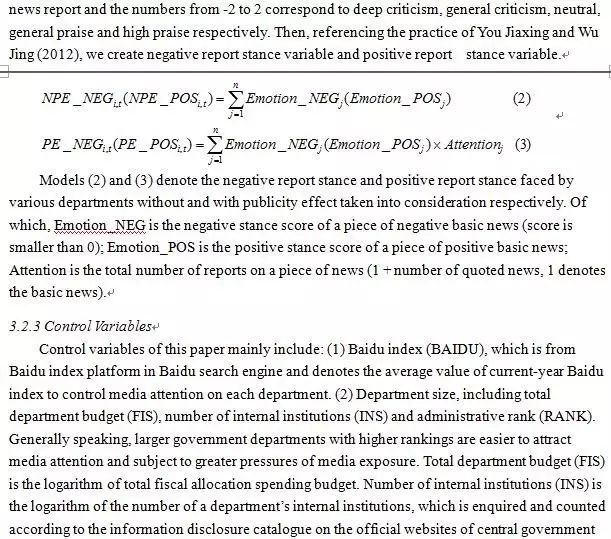
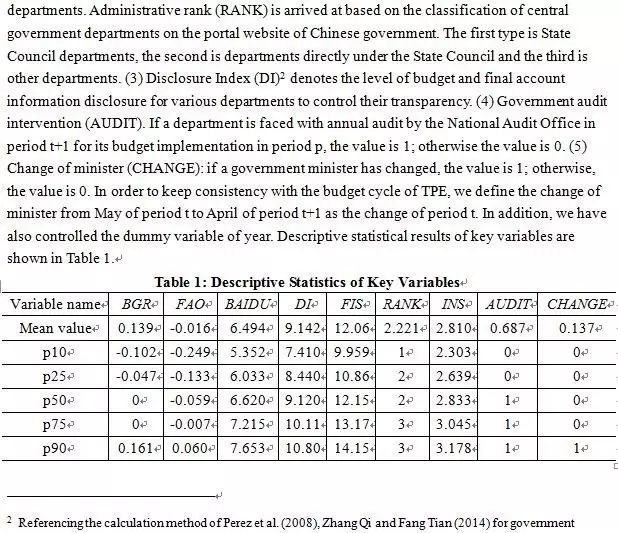
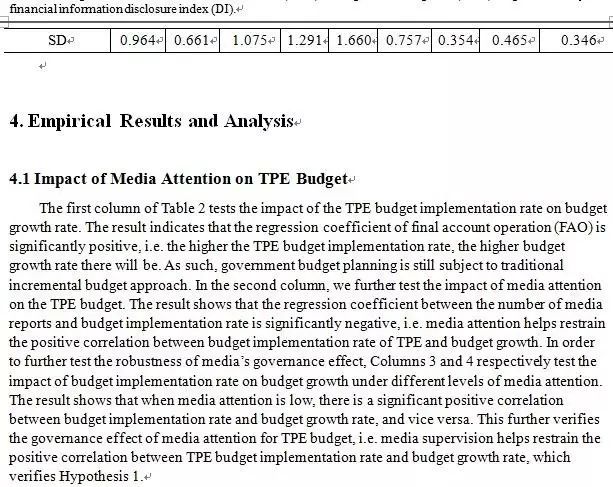


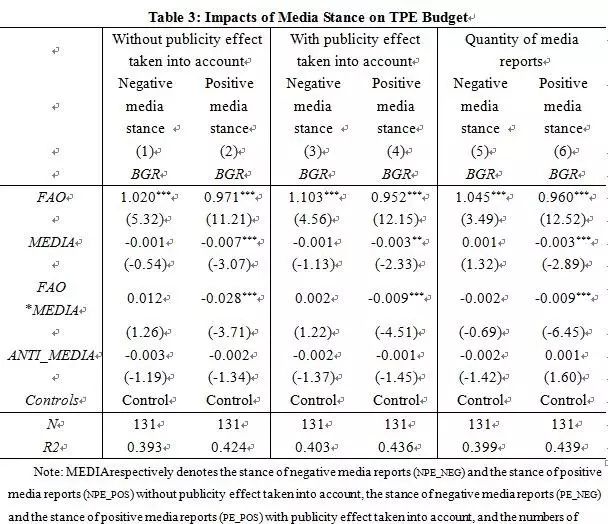

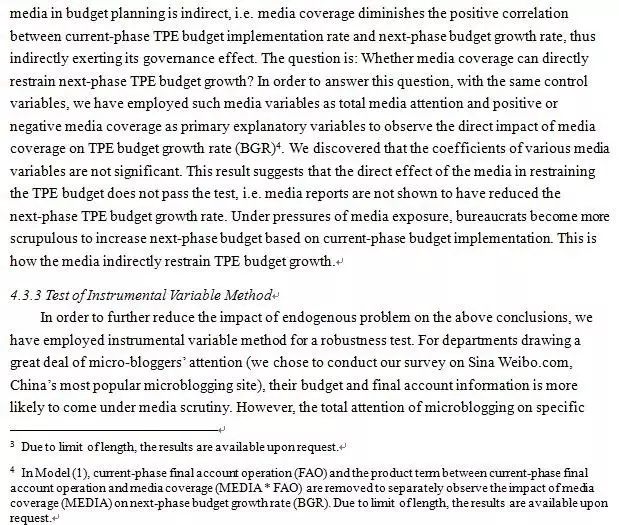
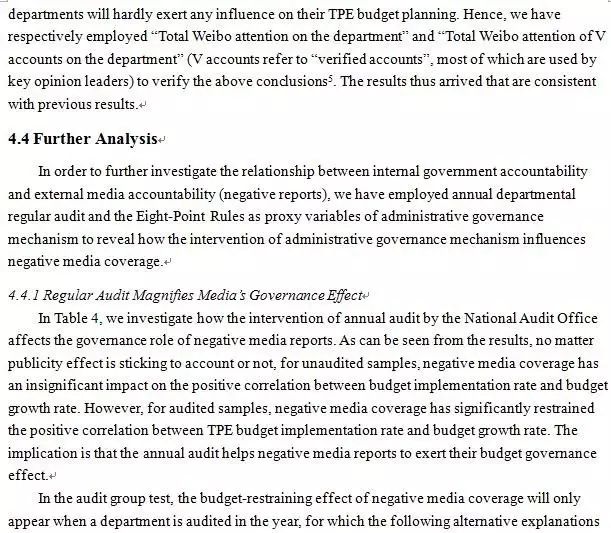
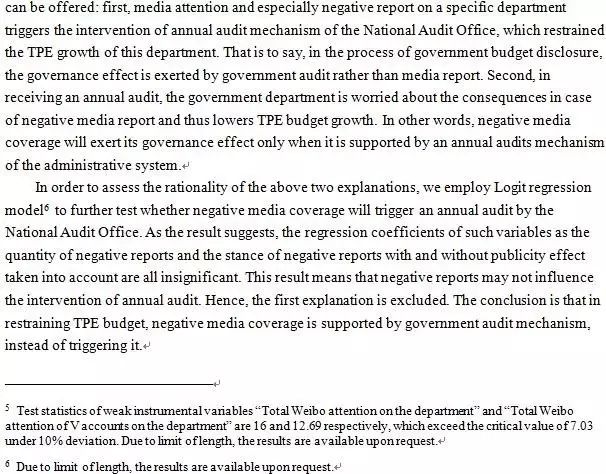
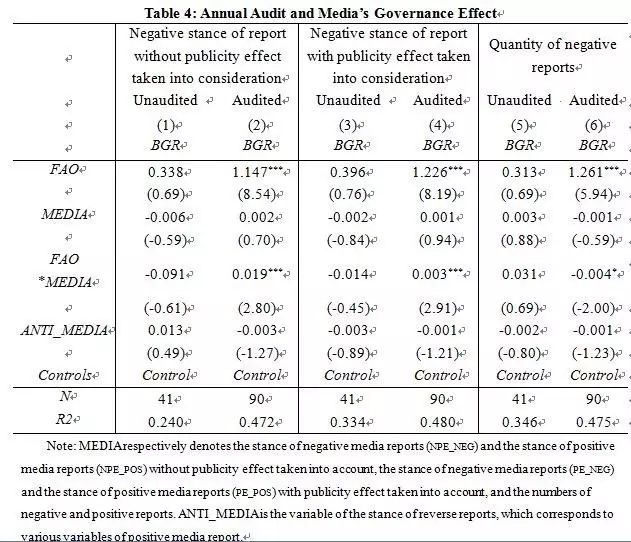
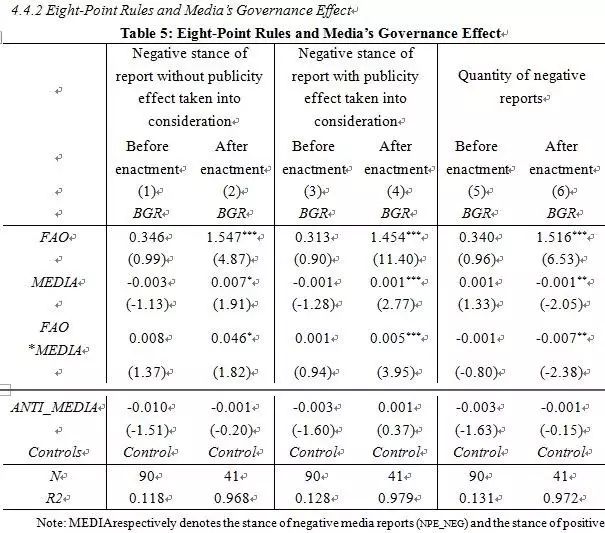
5. Concluding Remarks
This paper conducts anempirical study on how media supervision influences TPE budget for governmentdepartments. Evidence suggests that media supervision has a positive governanceeffect on budget management. Our study has arrived at the following findings: First,the higher the TPE budget implementation rate, the greater budget growth willbe. But this correlation can be restrained by media attention. Second,different stance of the media may exert different governance effects on TPEbudget. Positive coverage is regarded as an auxiliary “performance identification”indicator that increases the chance and extent for bureaucrats to receiveadministrative incentives, thus motivating them to restrain the positive impactof TPE budget implementation on budget growth. Only when administrativegovernance mechanism intervenes, e.g. the department receives annual auditand/or the Eight-Point Rules are enacted, will negative media coverage exert itsgovernance effect by increasing the chance and extent for bureaucrats bepenalized through “problem identification” mechanism. In addition, ingovernment budget management, negative media coverage may not trigger the interventionof administrative governance mechanism. On the contrary, it exerts governanceeffect under the support of administrative governance.
Significance of this study is reflected inthe following areas: First, this study has enriched and broadened research onthe media’s governance effect from the perspective of government budgetmanagement and verified that under China’s institutional background, the mediamay still play a positive role in public sector governance. Second, differentfrom previous studies that focus on negative reports, our study has found thatpositive media coverage may incentivize bureaucrats to pursue long-termreputational benefits through “performance identification” function and give upshort-term opportunistic and selfish behaviors, thus restraining the motive ofbureaucrats to increase TPE budget. To some extent, this confirms therationality of the media’s focus on making positive reports, which is of greatsignificance to developing an approach for media reform in the new situation.Third, although negative media coverage may not directly hold the governmentaccountable, it increases the chance and extent for bureaucrats to receiveadministrative penalties. When the government’s internal governance mechanismintervenes, negative media coverage may also exert its governance effect on TPEbudget through “problem identification” function, which provides theoreticalbasis and evidence support to the integration between the government’s internaladministrative accountability mechanism and external media’s accountabilitymechanism.
References:
1) Bhattacharya, Utpal, Neal Galpin, RinaRay, and Xiaoyun Yu. 2009. “The Role of theMedia in the Internet IPO Bubble.” Journalof Financial and Quantitative Analysis, 44(3): 657-682.
2) Bushee, Brian J., John E. Core, WayneGuay, and Sophia J. W. Hamm. 2010. “The Role of theBusiness Press as an Information Intermediary.” Journal of Accounting Research, 48 (1):1-19.
3) Chow, Chee W., Jean C. Cooper, andWilliam S. Waller. 1988. “ParticipativeBudgeting: Effects of A Truth-Inducing Pay Scheme and Information AsymmetrySlack and Performance.” The Accounting Review, 63(1): 111-122.
4) Core, John E., Wayne Guay, and David F.Larcker. 2008. “The Power of thePen and Executive Compensation.”Journal of Financial Economics, 88(1): 1-25.
5) Downs, Anthony. 1957. An Economic Theory of Democracy. NewYork: Harper and Row Press.
6) Dyck, Alexander, Natalya Volchkova, andLuigi Zingales. 2008. “The CorporateGovernance Role of the Media: Evidence from Russia.” Journal of Finance, 63(3): 1093-1163.
7) Erikson, Robert S., Michael B. MacKuen,and James A. Stimson. 2002. The MacroPolity. Cambridge: Cambridge University Press.
8) Gonzalez, Rodolfo A., and Stephen L.Mehay. 1985. “Bureaucracy andthe Divisibility of Local Public Output.” Public Choice, 45(1): 89-101.
9) Healy, Paul M., and Krishna G.Palepu. 2001. “Information Asymmetry, CorporateDisclosure, and the Capital Markets: A Review of the Empirical DisclosureLiterature.”Journal of Accounting and Economics, 31(1): 405-440.
10) Joe,Jennifer R., Henock Louis, and Dahlia Robinson. 2009. “Managers’and Investors’ Responses to Media Exposure of Board Ineffectiveness.” Journal of Financial and QuantitativeAnalysis, 44(3): 579-605.
11) Kong,Dongmin, Shasha Liu, and Qianwei Ying. 2013. “The Role of Media in CorporateBehaviors: Is it Eliminating Vice and Exalting Virtue or Adding Fuel to theFlames?” Management World, 7:145-162.
12) KrepsDavid M, Paul Milgrom, John Roberts, and Robert Wilson. 1982. “RationalCooperation in the Finitely Repeated Prisoners’ Dilemma.” Journal of Economic Theory, 27(2):245-252.
13) Leone,Andrew J., and Steve Rock. 2002. “Empirical Testsof Budget Ratcheting and Its Effect on Managers’ Discretionary Accrual Choices.” Journal of Accounting and Economics,33(1): 43-67.
14) Li,Peigong, and Yifeng Shen. 2010. “The Corporate Governance Role of Media:Empirical Evidence from China.” EconomicResearch Journal, 4: 14-27.
15) Miller,Gregory S.2006.“The Press as a Watchdogfor Accounting Fraud.”Journal of Accounting Research, 44(5): 1001-1033.
16) Nadeau,Richard, Richard G. Niemi, David P. Fan, and Timothy Amato. 1999. “EliteEconomic Forecasts, Economic News, Mass Economic Judgments, and PresidentialApproval.” TheJournal of Politics, 61(1): 109-135.
17) Niskanen,William A. 1971. Bureaucracy andRepresentative Government. Herndon: Transaction Publishers.
18) Perez,Carmen Caba, Manuel Pedro Rodriguez Bolivar, and Antonio M. Lopez Hernandez.2008. “E-Government Process and Incentives for Online Public FinancialInformation.” OnlineInformation Review, 32(3): 379-400.
19) Piotroski,Joseph D., T. J.Wong, and Tianyu Zhang. 2015. “PoliticalIncentive to Suppress Negative Information: Evidence from Chinese Listed Firms.” Journal of Accounting Research, 53(2):405-459.
20) Sanders,David, David Marsh, and Hugh Ward. 1993. “TheElectoral Impact of Press Coverage of the British Economy, 1979-87.” British Journal of Political Science,23(2): 175-210.
21) Soroka,Stuart N. 2006. “Good News and BadNews: Asymmetric Responses to Economic Information.” Journal of Politics, 68(2): 372-385.
22) You,Jiaxing, and Jing Wu. 2012. “Spiral of Silence: Media Sentiment and the AssetMispricing.” Economic Research Journal,7: 141-152.
23) Yu,Keping. 2000. Governance and GoodGovernance. Beijing: Social Science Academic Press.
24) Zhang,Qi, and Minkang Lv. 2015. “Is Media’s Blame and Demanding an ExplanationEffective in Government’s Budget Opening?” ManagementWorld, 6: 72-84.
25) Zhang,Qi, and Tian Fang. 2014. “Research on Financial Information Disclosure Qualityof Chinese Government.” AccountingResearch, 12: 53-59.
Zhang, Qi, Juan Zhang, and Minkang Lv.2013. “Evolution of Budget Institutions, Network Environment and TransmissionMechanism of Government Financial Information——Based on the Case of OpeningThree Public Expenditures of Ministry of Commerce.” Accounting Research, 12: 25-31.
Zheng,Zhigang, Dong Ding, and Changyun Wang. 2011. “Negative Media Coverage,Management Reputation and Form Performance Improvement: Evidence from China’sListed Firms.” Journal of FinancialResearch, 12: 163-176.
Zhou,Li-an. 2007. “Governing China’s Local Bureaucrats: An Analysis of PromotionTournament Model.” Economic ResearchJournal, 7: 36-50.
以上是关于原创Role of Media Coverage in Keeping Lid on Government Expenses的主要内容,如果未能解决你的问题,请参考以下文章
KLEE: Unassisted and Automatic Generation of High-Coverage Tests for Complex Systems Programs
无生物学重复RNA-seq分析 CORNAS: coverage-dependent RNA-Seq analysis of gene expression data without biologi
Development of a High Coverage Pseudotargeted Lipidomics Method Based on Ultra-High Performance Liqu
怎么合并Jacoco的Code Coverage Report
GeoServer发布tif影像服务出现Error rendering coverage on the fast path